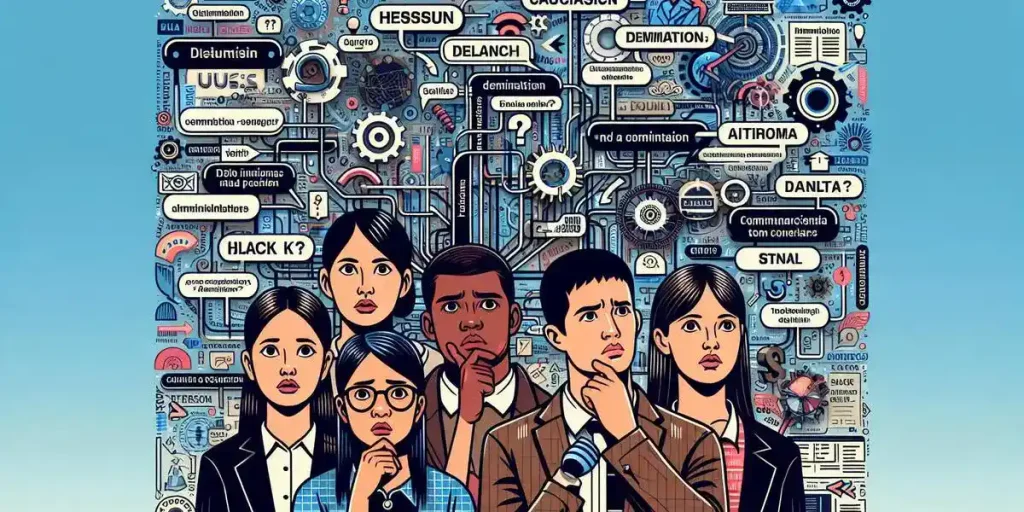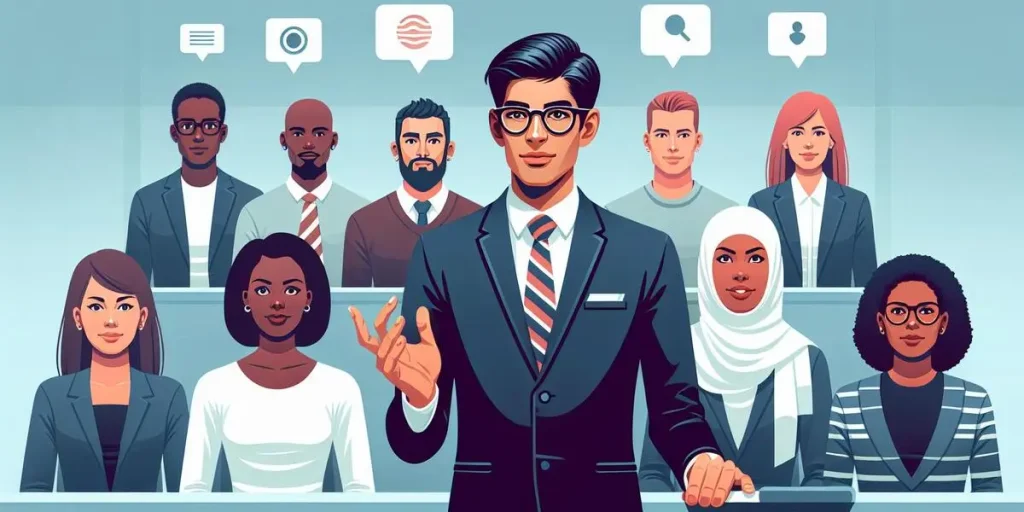Have you ever found yourself scratching your head in confusion during a conversation, even though both of you were speaking the same language? I’ve been there, and let me tell you, it’s not just you. One of the sneakiest culprits behind these misunderstandings is jargon. From the medical field to the retail industry, specialized language can create invisible walls between people.
Jargon barriers to communication occur when specialized terminology or technical language is used, hindering understanding among individuals who are not familiar with the terminology or field-specific vocabulary. This can impede effective communication and lead to confusion or misinterpretation.
Take my experience in Glasgow, for example. Even a simple conversation with a sales clerk turned into a puzzle because of the dialect and jargon used. It’s a clear reminder that speaking the same language doesn’t guarantee clear communication. Jargon, whether it’s medical terms or workplace slang, can alienate and confuse, turning what should be a straightforward exchange into a guessing game. Let’s dive into how jargon acts as a barrier to effective communication and what we can do about it.
Contents
Understanding Jargon Barriers to Communication
In my journey through diverse fields, I’ve encountered a universal hurdle to clear communication: jargon. It’s like I’m walking into a room where everyone speaks a different language. Let’s dive deeper into what jargon is and its various types, to understand how it becomes a barrier to effective communication.
What is Jargon?
Jargon, in its simplest form, is the specialized language used by a particular group, profession, or community. These are words or expressions that are familiar to those within the group but often perplexing to those outside of it.
During my time observing healthcare professionals, the use of medical abbreviations stood out. While these abbreviations served as efficient shorthand among peers, they often confused patients, highlighting jargon’s double-edged sword.
It’s not just about using complex words; it’s about the context and understanding that get lost when specialized language is used without considering the audience.
Types of Jargon
Jargon isn’t limited to one form or sector; it varies significantly. I’ve noticed at least two predominant types:
- Professional or Industry Jargon: This includes terminology specific to a field such as medicine, law, or technology. For instance, phrases like ‘CAD’ (Computer-Aided Design) in engineering or ‘arrhythmia‘ in healthcare. These terms facilitate precise communication among professionals but can alienate and confuse outsiders.
- Corporate Slang or Buzzwords: Often found in business environments, these include terms like ‘synergy’, ‘leverage’, or ‘bandwidth’. While aimed at enriching communication internally, they can come off as pretentious or vague to those not ‘in the know’.
Recognizing these types helps identify when and where jargon might create barriers. My quest for clear communication has shown me that awareness and empathetic adjustments to our language can bridge the gap jargon creates.
How Jargon Barriers Hinder Communication

Delving into the complex webs of communication, it’s evident that jargon creates significant barriers that are not always easy to navigate. As I explore deeper, it’s clear that the overuse of technical terms, the incomprehensibility of specialized language, and a noticeable lack of clarity and precision play pivotal roles in obstructing effective communication.
Overuse of Technical Terms
When stepping into the world of various industries, it’s like entering languages within languages. Each field comes equipped with its dictionary of terms and abbreviations. While these terms serve as shortcuts for experts, they can alienate those not versed in the specific language.
Medical jargon, for example, can seem like a foreign language to someone outside the healthcare profession, turning an attempt at communication into a confusing maze. It’s not just limited to medicine; IT, finance, and even marketing fields have their unique lexicons that can perplex outsiders.
This overreliance on industry-specific terms can significantly hinder the flow of information, making it a challenge to convey essential ideas and concepts to a broader audience.
Incomprehensible Language
The use of incomprehensible language goes hand in hand with the overuse of technical terms. It’s like trying to read a map with no legend or key. You can see paths and landmarks, but without understanding what they represent, navigating becomes a guessing game. Incomprehensible Language acts as a barrier, making it difficult for people to grasp the essence of the message.
When communication fails to bridge the gap between expertise and layman’s understanding, it can lead to misinformation, misunderstandings, and reciprocal frustration. Striking a balance between being informative and accessible is crucial. It’s about distilling complexity into simplicity without losing the message’s essence.
Lack of Clarity and Precision
Navigating through a conversation or document riddled with jargon is akin to being lost in a fog; you know there’s a clear path somewhere, but it remains elusive. The Lack of Clarity and Precision in communication, especially in professional settings, can lead to inefficiencies, errors, and missed opportunities. Clarity is not about diluting information but rather about making it accessible.
Precision involves choosing the right words that convey the exact message intended, leaving little room for interpretation or confusion. When information is presented clearly and precisely, it enhances understanding, fosters trust, and promotes efficiency.
By recognizing these barriers and actively seeking ways to minimize their impact, I’m striving to contribute to more effective and inclusive communication. Bridging this gap doesn’t mean eliminating technical language altogether but rather using it judiciously and always with the audience’s needs in mind.
Impact of Jargon Barriers on Communication

Communication is the backbone of human interaction, and understanding each other is crucial for effective communication. However, jargon barriers often disrupt this understanding, causing a range of issues from minor misunderstandings to significant communication breakdowns. I’ll delve into how these barriers affect communication, focusing on miscommunication and misunderstandings, the exclusion of non-experts, and the increase in confusion and frustration.
Miscommunication and Misunderstandings
Jargon, by its nature, is exclusive. It’s the specialized language used by certain groups, and when it infiltrates conversations with those outside these groups, it often leads to miscommunication and misunderstandings. Think about a doctor using medical abbreviations with a patient. The patient, unfamiliar with these terms, might miss crucial information about their health condition. This isn’t limited to the healthcare sector; technical, financial, and legal fields are also rife with jargon that can obfuscate meaning and intent.
For me, the crux of the problem lies in the assumption that the listener understands these terms. This assumption is dangerous because it can lead to misinformation and erosion of trust, especially when the communication involves important details about services, policies, or health advisories.
Exclusion of Non-Experts
Jargon not only confuses – it excludes. When organizations or professionals use insider language in broader communications, they inadvertently create an ‘us versus them’ scenario, where the ‘them’ are non-experts or the general audience. It’s akin to being at a party where everyone else shares an inside joke you’re not privy to. This feeling of being on the outside can prevent people from engaging with the content, asking questions, or taking necessary actions based on the information provided.
This exclusion has tangible impacts, particularly in sectors like finance and healthcare, where understanding is imperative to making informed decisions. For instance, an investment firm that uses complex financial terminology in customer communications might inadvertently prevent its customers from taking advantage of certain opportunities simply because they don’t understand the benefits or conditions.
Increased Confusion and Frustration
Repeated instances of jargon-laden communication can breed confusion and frustration among audiences. It’s frustrating to constantly seek clarification or turn to external sources to interpret what should be straightforward information. Eventually, this frustration can lead to disengagement. Customers or clients might avoid interactions out of fear of not understanding, or worse, they might seek services elsewhere, feeling that their needs and concerns are not being addressed in a language they comprehend.
Studies and surveys highlight how commonplace this frustration is. In the context of the COVID-19 pandemic, new terminologies and abbreviations emerged rapidly, adding layers of confusion in a situation where clear and accessible communication was more critical than ever. The lesson here is that organizations must prioritize clarity over complexity to maintain trust and engagement, especially during crises where timely and understandable communication is crucial.
In navigating through an era where information is at everyone’s fingertips, it’s essential to communicate in a way that resonates with the broadest audience possible. Achieving this requires a conscious effort to minimize jargon and explain concepts in simple terms. This isn’t about dumbing down content; it’s about making information accessible and understandable, which, in my view, is a hallmark of effective communication.
Strategies for Overcoming Jargon Barriers

Simplify and Clarify
In my experience, one of the most effective ways to bridge the communication gap caused by jargon is to Simplify and Clarify. This means breaking down complex concepts into easier, more digestible pieces, and using language that’s accessible to everyone in the audience, regardless of their background.
I’ve found that using analogies or metaphors that relate to everyday experiences can significantly enhance understanding. It’s crucial not to underestimate the power of simplicity; often, the most straightforward explanation is the most impactful. By avoiding unnecessarily complicated language, we can make information more approachable and foster a more inclusive environment.
Define and Explain
Another strategy I always emphasize is the need to Define and Explain any specialized terms that do need to be used. There are instances where specific jargon is unavoidable because it encapsulates complex concepts succinctly. In such cases, I make it a point to provide clear definitions and, if possible, additional explanations or paraphrasing to ensure that my message is comprehensible.
This approach not only aids understanding but also empowers the audience, allowing them to feel more connected to the subject matter. Additionally, creating a glossary or a reference list at the end of documents or presentations can be incredibly helpful for audiences to refer back to.
Provide Context and Examples
Context is king when it comes to overcoming barriers to communication, including those posed by jargon. By providing context and examples, I aim to paint a clearer picture for the audience, enabling them to see how specific concepts apply in real-world scenarios. Illustrative examples can significantly aid comprehension by linking abstract concepts to familiar situations.
I’ve noticed that when individuals can relate new information to their own experiences or knowledge, it not only enhances their understanding but also increases their retention of the information. This approach effectively bridges the gap between complex jargon and the audience’s existing knowledge base, making the communication process more effective.
Conclusion
Breaking down jargon barriers isn’t just about simplifying language; it’s about creating connections. I’ve shared how using analogies, defining terms, and providing relatable examples can transform complex topics into accessible knowledge. We must foster an environment where information is not just shared but understood.
By prioritizing clarity over complexity, we not only enhance understanding but also build a more inclusive community. Let’s commit to making our communications clearer and more effective, ensuring that our messages resonate with everyone. Remember, the power of our words lies not in their complexity, but in their ability to connect and be understood.
Boko Ducky has over 10 years of experience in helping individuals and organizations improve their communication skills.



